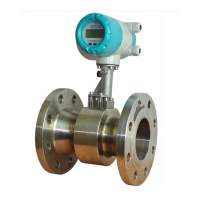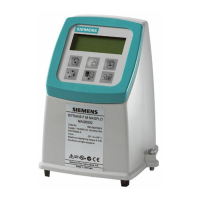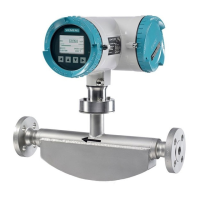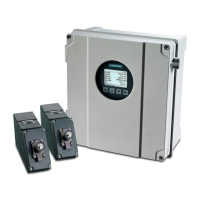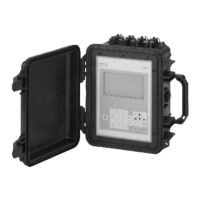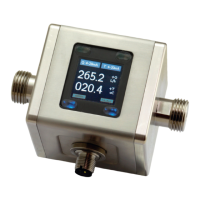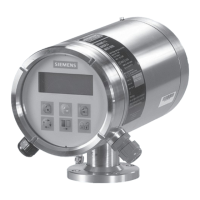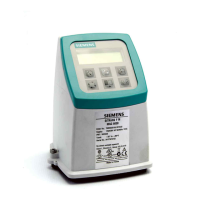Do you have a question about the Siemens SITRANS FX330 and is the answer not in the manual?
Documents the revision status of electronic equipment and its effect on compatibility.
Specifies the applications and limitations for vortex flowmeters, including media suitability.
States the manufacturer's certification of product testing and compliance with directives and regulations.
Explains the PED key for device rating and residual risk analysis according to the directive.
Covers copyright, disclaimer, liability, documentation information, and warning symbols.
Provides essential safety guidelines for personnel involved in installation, commissioning, operation, and maintenance.
Lists the items included in the device packaging and provides inspection instructions.
Details the different variants and optional designs available for the flowmeters.
Illustrates and describes various configurations of flanged devices with display options.
Illustrates and describes sandwich versions, highlighting the use of centering rings for installation.
Explains the redundant system with two sensors and converters for enhanced reliability and availability.
Describes the configuration where the flow sensor and signal converter are installed separately.
Details F1R and F2R versions offering integrated diameter reduction for improved accuracy.
Provides a diagram identifying key components of the device, such as signal converter and flow sensor.
Explains the optional FAD function for measuring compressor capacity as free air delivery.
Describes the optional function for calculating heat amount in steam or hot water systems.
Explains how to determine energy consumed by a system using flowmeter and an additional temperature sensor.
Details the membrane vent integrated for process sealing and prevention of pressure build-up.
Illustrates an example nameplate and explains its various components and information.
Provides general instructions for installation, including inspection and checking packing lists.
Specifies conditions for storing the device, including location, temperature, and packaging.
Provides instructions and cautions regarding safe transport of the device, including lifting methods.
Outlines requirements for accurate measurement, pipe filling, flow profile, and environmental factors.
Shows recommended installation positions for measuring liquids in various pipe orientations.
Illustrates recommended and not recommended installations for steam and gas measurements.
Recommends installing the device upstream of control valves to avoid vortex formation.
Shows preferred mounting positions for devices without a pressure sensor in horizontal and vertical pipes.
Illustrates preferred mounting positions for devices with pressure sensors, including syphon orientation.
Specifies required straight pipe lengths upstream of the device under various conditions.
Defines the required straight pipe length downstream of the device.
Explains the use and installation of flow straighteners to reduce inlet section requirements.
Provides general notes on installing the device, including gasket, flow direction, and flange concentricity.
Provides general notes on installing the device, including gasket, flow direction, and flange concentricity.
Details the procedure for installing devices in a sandwich design using centering rings.
Outlines the steps for installing devices in a flange design, including gasket placement.
Describes pipe mounting and wall mounting procedures for the field housing of remote versions.
Advises on applying heat insulation for applications with high medium temperatures.
Explains how to rotate the connection housing to the desired position.
Provides instructions on how to detach, turn, and reattach the display module.
Describes the optional weather protection cover for reducing electronics heating from solar radiation.
Emphasizes safety precautions for electrical connections, including power disconnection and national regulations.
Details the steps and diagrams for connecting the signal converter to terminal compartments.
Covers power supply, current output, current input, binary, limit switch, pulse, and status outputs.
Specifies the power supply requirements and calculation formula for the signal converter.
Explains how to connect the current loop and provides a diagram for electrical connection.
Describes connecting an external transmitter to the signal converter via current input.
Explains the configuration and activation of the binary output for various functions.
Details connection types for binary output as NAMUR or transistor output, with terminal configurations.
Explains connections and configuration for pulse and frequency outputs, including signal definition.
Describes the terminal connections for status output and provides technical data for terminals.
Shows connection terminals and cable strand colors for the remote version.
Explains grounding procedures for compact and remote versions, emphasizing proper grounding for accurate measurement.
Details ingress protection requirements (IP66/67, IP68, IP69K) and essential points for maintaining protection.
Describes the start-up screen that appears after the device performs a self-test.
Notes that the measuring device is largely maintenance-free and emphasizes observing application limits.
Identifies the display, mechanical keys, bar magnet, and bargraph indication.
Illustrates the display format for navigating menus, submenus, and functions.
Shows how parameters are displayed and modified within the device's menu system.
Explains the display for selecting functions with a preview of current parameter values.
Explains the functionality of keys, switching between modes, and changing settings within the menu.
Provides a table describing the operation of various keys and their corresponding symbols.
Details how to switch between the measuring mode and the menu mode using specific buttons.
Guides the user on navigating menus, changing values, and saving configurations.
Explains how to select characters (numbers, letters, symbols) when changing parameters.
Discusses the display format for numerical values and the definition of user-defined units.
Outlines the multi-level security concept, access levels, default passwords, and permissions.
Provides a summary of key functions and units available in the device's menu structure.
Lists the available display languages for the device, depending on communication options.
Details the available gas selections for fluid selection, wet gas, or gas mixture measurements.
Lists the selectable units for volume flow, normalized volume flow, mass flow, and other measurements.
Provides instructions for replacing the signal converter or LC display, including CG number compatibility.
Explains the importance of greasing or replacing O-rings when opening housing covers.
States the manufacturer's policy on keeping functionally adequate spare parts available for a period after delivery.
Lists services offered by the manufacturer to support customers after warranty expiration.
Details the procedure for returning a device, including packaging requirements and associated cautions.
Provides legal notice and instructions for separate collection and disposal of WEEE equipment.
Explains the Karman vortex street principle used for vortex flowmeters and the relationship between vortex frequency and flow velocity.
Lists general technical data, including measuring system, signal converter, flow sensor, display, and communication interfaces.
Provides detailed dimensions and weights for flange, sandwich, and remote versions of the device.
Provides detailed dimensions and weights for flange versions based on nominal size and pressure rating.
Lists dimensions and weights for sandwich versions with signal converters in aluminum and stainless steel housings.
Presents dimensions for the remote version, including flange and sandwich configurations.
Provides measuring ranges for water and air at different nominal sizes and pressures.
Documents the revision status of electronic equipment and its effect on compatibility.
Specifies the applications and limitations for vortex flowmeters, including media suitability.
States the manufacturer's certification of product testing and compliance with directives and regulations.
Explains the PED key for device rating and residual risk analysis according to the directive.
Covers copyright, disclaimer, liability, documentation information, and warning symbols.
Provides essential safety guidelines for personnel involved in installation, commissioning, operation, and maintenance.
Lists the items included in the device packaging and provides inspection instructions.
Details the different variants and optional designs available for the flowmeters.
Illustrates and describes various configurations of flanged devices with display options.
Illustrates and describes sandwich versions, highlighting the use of centering rings for installation.
Explains the redundant system with two sensors and converters for enhanced reliability and availability.
Describes the configuration where the flow sensor and signal converter are installed separately.
Details F1R and F2R versions offering integrated diameter reduction for improved accuracy.
Provides a diagram identifying key components of the device, such as signal converter and flow sensor.
Explains the optional FAD function for measuring compressor capacity as free air delivery.
Describes the optional function for calculating heat amount in steam or hot water systems.
Explains how to determine energy consumed by a system using flowmeter and an additional temperature sensor.
Details the membrane vent integrated for process sealing and prevention of pressure build-up.
Illustrates an example nameplate and explains its various components and information.
Provides general instructions for installation, including inspection and checking packing lists.
Specifies conditions for storing the device, including location, temperature, and packaging.
Provides instructions and cautions regarding safe transport of the device, including lifting methods.
Outlines requirements for accurate measurement, pipe filling, flow profile, and environmental factors.
Shows recommended installation positions for measuring liquids in various pipe orientations.
Illustrates recommended and not recommended installations for steam and gas measurements.
Recommends installing the device upstream of control valves to avoid vortex formation.
Shows preferred mounting positions for devices without a pressure sensor in horizontal and vertical pipes.
Illustrates preferred mounting positions for devices with pressure sensors, including syphon orientation.
Specifies required straight pipe lengths upstream of the device under various conditions.
Defines the required straight pipe length downstream of the device.
Explains the use and installation of flow straighteners to reduce inlet section requirements.
Provides general notes on installing the device, including gasket, flow direction, and flange concentricity.
Provides general notes on installing the device, including gasket, flow direction, and flange concentricity.
Details the procedure for installing devices in a sandwich design using centering rings.
Outlines the steps for installing devices in a flange design, including gasket placement.
Describes pipe mounting and wall mounting procedures for the field housing of remote versions.
Advises on applying heat insulation for applications with high medium temperatures.
Explains how to rotate the connection housing to the desired position.
Provides instructions on how to detach, turn, and reattach the display module.
Describes the optional weather protection cover for reducing electronics heating from solar radiation.
Emphasizes safety precautions for electrical connections, including power disconnection and national regulations.
Details the steps and diagrams for connecting the signal converter to terminal compartments.
Covers power supply, current output, current input, binary, limit switch, pulse, and status outputs.
Specifies the power supply requirements and calculation formula for the signal converter.
Explains how to connect the current loop and provides a diagram for electrical connection.
Describes connecting an external transmitter to the signal converter via current input.
Explains the configuration and activation of the binary output for various functions.
Details connection types for binary output as NAMUR or transistor output, with terminal configurations.
Explains connections and configuration for pulse and frequency outputs, including signal definition.
Describes the terminal connections for status output and provides technical data for terminals.
Shows connection terminals and cable strand colors for the remote version.
Explains grounding procedures for compact and remote versions, emphasizing proper grounding for accurate measurement.
Details ingress protection requirements (IP66/67, IP68, IP69K) and essential points for maintaining protection.
Describes the start-up screen that appears after the device performs a self-test.
Notes that the measuring device is largely maintenance-free and emphasizes observing application limits.
Identifies the display, mechanical keys, bar magnet, and bargraph indication.
Illustrates the display format for navigating menus, submenus, and functions.
Shows how parameters are displayed and modified within the device's menu system.
Explains the display for selecting functions with a preview of current parameter values.
Explains the functionality of keys, switching between modes, and changing settings within the menu.
Provides a table describing the operation of various keys and their corresponding symbols.
Details how to switch between the measuring mode and the menu mode using specific buttons.
Guides the user on navigating menus, changing values, and saving configurations.
Explains how to select characters (numbers, letters, symbols) when changing parameters.
Discusses the display format for numerical values and the definition of user-defined units.
Outlines the multi-level security concept, access levels, default passwords, and permissions.
Provides a summary of key functions and units available in the device's menu structure.
Lists the available display languages for the device, depending on communication options.
Details the available gas selections for fluid selection, wet gas, or gas mixture measurements.
Lists the selectable units for volume flow, normalized volume flow, mass flow, and other measurements.
Provides instructions for replacing the signal converter or LC display, including CG number compatibility.
Explains the importance of greasing or replacing O-rings when opening housing covers.
States the manufacturer's policy on keeping functionally adequate spare parts available for a period after delivery.
Lists services offered by the manufacturer to support customers after warranty expiration.
Details the procedure for returning a device, including packaging requirements and associated cautions.
Provides legal notice and instructions for separate collection and disposal of WEEE equipment.
Explains the Karman vortex street principle used for vortex flowmeters and the relationship between vortex frequency and flow velocity.
Lists general technical data, including measuring system, signal converter, flow sensor, display, and communication interfaces.
Provides detailed dimensions and weights for flange, sandwich, and remote versions of the device.
Provides detailed dimensions and weights for flange versions based on nominal size and pressure rating.
Lists dimensions and weights for sandwich versions with signal converters in aluminum and stainless steel housings.
Presents dimensions for the remote version, including flange and sandwich configurations.
Provides measuring ranges for water and air at different nominal sizes and pressures.
| Type | Vortex flowmeter |
|---|---|
| Measuring principle | Vortex shedding |
| Housing Material | Aluminum or Stainless Steel |
| Accuracy | ±1% of measured value |
| Output | 4-20 mA, pulse |
| Power supply | 24 V DC |
| Nominal diameter | DN 15 to DN 300 |
| Communication | HART |
| Material (wetted parts) | Stainless steel |
| Ingress protection | IP68 |
| Temperature range | -40°C to +400°C (-40°F to +752°F) |
